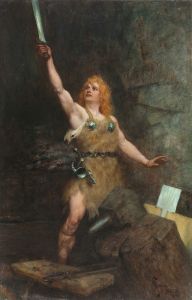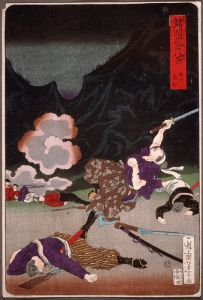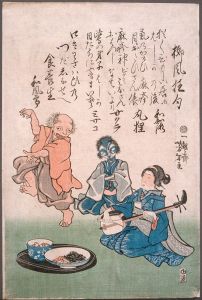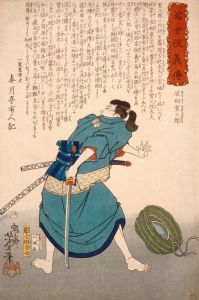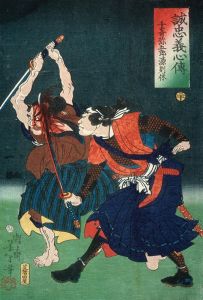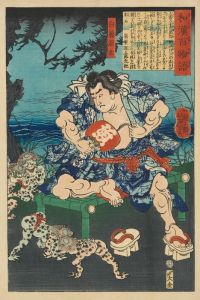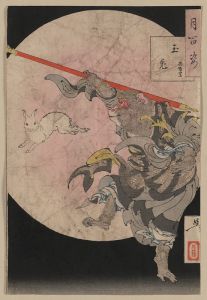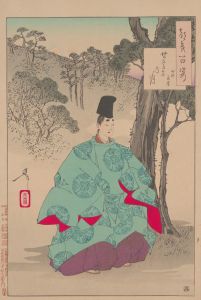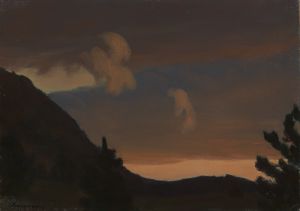
Mashiba Hisayoshi, the Tairyō, in Lightening
A hand-painted replica of Tsukioka Yoshitoshi’s masterpiece Mashiba Hisayoshi, the Tairyō, in Lightening, meticulously crafted by professional artists to capture the true essence of the original. Each piece is created with museum-quality canvas and rare mineral pigments, carefully painted by experienced artists with delicate brushstrokes and rich, layered colors to perfectly recreate the texture of the original artwork. Unlike machine-printed reproductions, this hand-painted version brings the painting to life, infused with the artist’s emotions and skill in every stroke. Whether for personal collection or home decoration, it instantly elevates the artistic atmosphere of any space.
"Lightning" by Tsukioka Yoshitoshi is a notable work from the late Edo period, showcasing the artist's distinctive style and thematic focus. Tsukioka Yoshitoshi (1839–1892) was a prominent Japanese ukiyo-e artist, renowned for his innovative approach to traditional woodblock printing. His works often depicted historical and mythical subjects, reflecting the cultural and social transitions of Japan during his lifetime.
The artwork "Lightning" features Mashiba Hisayoshi, also known as the Tairyō, a figure rooted in Japanese history. Hisayoshi is a reference to Toyotomi Hideyoshi (1537–1598), one of Japan's great unifiers, who played a crucial role in the Sengoku period, a time of social upheaval, political intrigue, and near-constant military conflict. Hideyoshi rose from humble beginnings to become a preeminent daimyo, warrior, general, and politician, eventually succeeding his lord, Oda Nobunaga, and bringing an end to the Sengoku period.
In Yoshitoshi's depiction, the use of lightning is symbolic and dramatic, emphasizing the power and intensity associated with Hideyoshi's character and his historical impact. The portrayal of lightning in Japanese art often signifies sudden change, enlightenment, or divine intervention, aligning with Hideyoshi's rapid rise to power and his transformative influence on Japan.
Yoshitoshi's work is characterized by its dynamic composition and vivid imagery, capturing the viewer's attention through bold lines and striking contrasts. His style evolved throughout his career, incorporating elements of Western art techniques, which were becoming increasingly influential in Japan during the Meiji Restoration. This period marked a significant shift as Japan opened up to the West, leading to cultural exchanges that affected various aspects of Japanese life, including art.
"Lightning" is part of Yoshitoshi's broader oeuvre that often explored themes of heroism, the supernatural, and the complexities of human nature. His works are celebrated for their emotional depth and technical mastery, contributing to the revival of ukiyo-e during a time when the art form was facing decline due to modernization and the advent of new printing technologies.
Yoshitoshi's legacy is significant in the history of Japanese art, as he is often credited with revitalizing the ukiyo-e tradition and influencing subsequent generations of artists. His ability to blend traditional Japanese themes with contemporary influences created a unique artistic expression that resonated with audiences both in Japan and abroad.
"Lightning" by Tsukioka Yoshitoshi remains an important piece for understanding the cultural and historical narratives of Japan, as well as the evolution of Japanese art during a pivotal era. The artwork not only reflects the life and achievements of Toyotomi Hideyoshi but also exemplifies Yoshitoshi's skill in capturing the essence of his subjects through the medium of woodblock printing.





